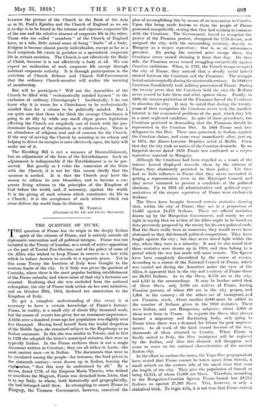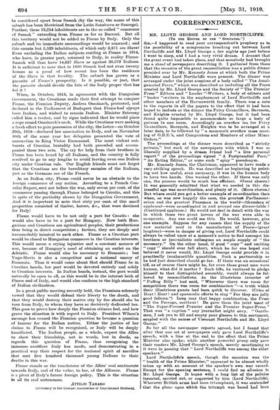THE QUESTION OF FIUME.
ITIHE question of Fiume has its origin in the deeply Italian _L spirit of the citizens of Fiume, and is entirely outside all diplomatic convention and all political intrigue. Fiume was not included in the Treaty of London, as a result of active opposition ea the part of Tsarist Pan-Slavism, and of the policy of some of the Allies who wished to keep Fiume in reserve as a bait with which to induce Austria to accede to a separate peace. Yet in this same Treaty the frontiers of Italy were brought to the western limits of the city. In it Italy was given the position of Cantrida, where there is the most popular bathing establishment of the Fiume suburbs, and where some of that city's factories are situated. Realizing that she was excluded from the national redemption, the city of Fiume took action on her own initiative, and on October 29th, 1918, declared her annexation to the Kingdom of Italy.
To get a complete understanding of this event it is necessary to have a certain knowledge of Fiume's history. Fiume, in reality, is a small city of about fifty thousand souls, but the course of events has given her an enormous importance. A little over a hundred years ago her population was slightly over five thousand. Having freed herself from the feudal despotism of the Middle Ages, she remained subject to the Hapsburgs as an Italian commune. In this she was similar to Trieste, and in fact in 1526 she adopted the latter's municipal statutes, that were so typically Italian. In the Fiume archives there is not a single document written in Croatian; they are all either in Latin—the most ancient ones—or in Italian. The documents that were to be circulated among the people—for instance, the food prices in the sixteenth century—were drawn up in Italian, bearing the explanation, " that this may be understood by all." By a decree, dated 1776, of the Empress Maria Theresa, who wished to conciliate the Magyars, Fiume was detached from Istria, that is to say Italy, to whom, both historically and geographically, she had belonged until then. In attempting to annex Fiume to Hungary, the Viennese Government, however, conceived the plan of accomplishing this by means of an annexation to Croatia. Upon this being made known to them the people of Fiume protested energetically, stating that they had nothing in common with the Croatians. The Government, forced to recognize the justice of the Fiumian protest, abrogated the 1776 decree, and assigned the city, with the surrounding territory, directly to Hungary as a corpus separatunt ; that is, as an autonomous province. On seeing the coveted prize escape them, the Croatians never ceased claiming it from that day. On their side, the Fiumians never ceased struggling energetically against Croatian ambitions. When, in 1797, the French troops occupied the city of Fiume, they noticed that a deadly racial hatred existed between the Croatians and the Fiumians. The struggle lasted uninterruptedly during the nineteenth century. In 1848 the Croatians fraudulently took military possession of Fiume. During the twenty years that the Croatians held the city, the Italians never ceased to hate them and rebel against them. Filially, iu 1868, the intense patriotism of the Fiumians forced the Croatians to abandon the city. It may be noted that during the twenty years of their occupation the Croatians never took the smallest interest in the economical problems of the port, which they left in a most neglected condition. In spite of these precedents, the Croatians persisted in demanding that the Fiumians should be represented in the Croatian Diet. In 1868 Fiume sent two delegates to this Diet. These men protested, in Italian, against the Croatian claims, and came away immediately after, just as, in 1874, the Alsace-Lorraine Deputies acted at Berlin. From that day the city took no notice of the Croatian demands. By an Imperial decree dated 1870 Fiume was confirmed as a corpus separatum annexed to Hungary.
Although the Croatians had been expelled as a result of the intense hatred displayed towards them by the citizens of Fiume, they obstinately persisted in their policy. Yet they had so little influence in Fiume that they never succeeded in getting a representation even in the Municipal Council, and they never ventured to present a candidate at the political elections. Up to 1918 all administrative and political repre- sentatives of the corpus separatuni of Fiume were exclusively
Italians.
The Slava have brought forward certain statistics showing that, within the city of Fiume, they are in a proportion of 15,687 against 24,212 Italians. These are official statistics drawn up by the Hungarian Government, and surely we ara right in saying that no action of the Allies ought to be based on data previously prepared by the enemy for his own political ends. Had the Slays really been so numerous, they would never have abstained as they did from all political competition. They have fought against the city ; but they never dared fight within the city, where they were in a minority. It may be also noted that these statistics were drawn up in 1910, and thus belong to a period which the war has made still more remote. The figures have been completely discredited by the course of events. According to a census of the National Council of Fiume, which was carried out during the Armistice under the eyes of the Allies, it appeared that in the city and territory of Fiume there are 28,911 Italians, As to the Slays, 6,576 are in the city. and 4,351 in the surroundings. It may be further noted that of these Slays, only 2,094 are natives of Fiume, having Fiumian parents, of whom 490 arc in the city proper, and 1,604 in the country : all the others are of immigrant, and not Fiumian, stock. About another 6,000 must be added to the number of Italians given in the 1910 statistics. These were Italian, and not Hungarian, subjects ; about 2,000 of them were born in Fiume. As regards the Slays, they always formed a migratory and fluctuating body, only going to Fiume when there was a demand for labour for port improve- ments. As all work of the kind ceased because of the war, thousands of them returned to Croatia. When Fiume is finally united to Italy, the Slav immigrant will be replaced by the Italian, and thus this element will disappear and cease to react on the national characteristics of the ancient Italian city. In the effort to confuse the issues, the Yugo-Slav propagandists have stated that Fiume cannot be taken apart from Sussak, a small suburb on the eastern side of the small river that runs the length of the city. They give the population of Sussak as being 13,214, of whom 11,000 are Slays. Therefore, according to the Hungarian-Croatian figures, Fiume-Sussak has 24,212 Italians as against 27,393 Slays. This, however, is only a statistical trick. To begin with, it is not true that Fiume cannot
be considered apart from Swank (by the way, the name of this suburb has been Slavicized from the Latin Sansicovo or Sansego). Further, these 13,214 inhabitants are in the so-called " commune of Sussak " extending from Flume as far as Buccari. But all this territory would not be added to Flume by Italy. Only the suburb and its immediate surroundings would be annexed ; and this counts but 5,539 inhabitants, of which only 3,871 are Slays! Even excluding the Italian subjects residing at Fiume in 1914, who have, in greater part, returned to Italy, in reality Fiume- Sussak will thus have 14,837 Slays as against 30,579 Italians. It is sufficient to note that in 1860 Sussak had not even twenty houses as a proof of how recent has been the residence of the Slave in that locality. The suburb has grown as a parasite of Fiume's prosperity. Is it possible, or just, that the parasite should decide the fate of the body proper that has fed it ?
When, in October, 1918, in agreement with the Hungarian Government, the Croatians made their first attempt to conquer Fiume, the Fiumian Deputy, Andrea Ossoivach, protested, and declared in the Parliament of Budapest that Flume had always been Italian, and wished to remain Italian. Minister Sztereny called him a traitor, and by signs indicated that he would place a rope round Ossoinach's neck. While the Croatians were making a fresh effort to gain possession of the city, the latter—on October 29th, 1918—declared her annexation to Italy, and on November 10th of the same year her delegates presented the vote of annexation to King Victor Emmanuel The most violent out. burets of Croatian brutality had both preceded and accom- panied these two acts. The cry for help from their brothers in Fiume has been heard by all Italians, and the country is fully resolved to go to any lengths to avoid leaving even one Italian city under Croatian rule. Our English friends must not forget that the Croatians are the hereditary enemies of the Italians, just as the Germans are of the French.
As an Italian city, Fiume could never be an obstacle to the foreign commerce of any nation. According to a French Con- sular Report, sent out before the war, only seven per cent. of the commerce passing through Fiume belonged to Croatia, and this in spite of the partiality shown by the Hungarian Government And it is important to note that sixty per cent. of this small proportion consisted of timber, horses, & a, that were destined for Italy!
Fiume would have to be not only a port for Croatia : she would also have to be a port for Hungary. Now both Hun- garians and Croatians are agricultural peoples, their productions thus being in direct competition ; further, they are deeply and irreconcilably inimical to each other. Fiume as a Croatian port would be closed to Hungarian commerce in the Croatian interests. This would mean is crying injustice and a constant menace of war, because of Hungary's need of obtaining an outlet on the Adriatic. Fiume would also be necessary to Rumania; but Yugo-Slavia is also a competitor and a national enemy of Rumania. Thus it would come about that should Mum be in Croatian hands, her port would be devoted entirely and solely to Croatian interests. In Italian hands, instead, the port would naturally be open to all, as this would be in the interest both of Fiume and of Italy, and would also conform to the high standard of Italian civilization.
In a great public meeting recently held, the Fiumians solemnly vowed that they would defend their liberty to the death, and that they would destroy their native city by fire should she be torn from Italy, to whom they have so decisively dedicated her. This goes to prove how deeply the Fiumian citizens feel, and how grave the situation is with regard to Italy. President Wilson's message has caused the Fiumian question to become a question of honour• for the Italian nation. Either the justice of her claims to Flume will be recognized, or Italy will be deeply humiliated. The Italian people, as a whole, expect the Allies to show their friendship, not in words, but in deeds, as regards this question of Fiume, thus recognizing the immense sacrifices Italy has made, and demonstrating in a practical way their respect for the national spirit of sacrifice that sent five hundred thousand young Italians to their deaths in this war.
Flume stands as the touchstone of the Allies' real sentiments towards Italy, and of the value, to her, of the Alliance. Fiume is a pivot of Italy's future foreign policy. This is the situation in all its real seriousness.
Arnuo Tauso
(Secretary to the General Association of unredeemed Itatiamo.



































 Previous page
Previous page